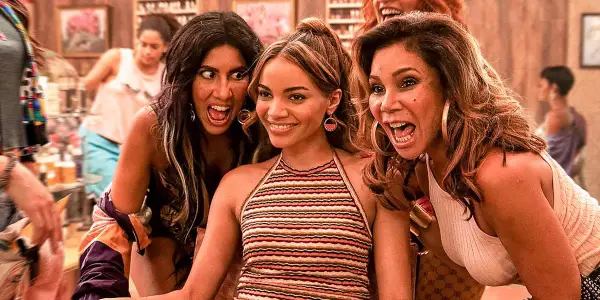Tribeca Film Festival 2021: IN THE HEIGHTS

Stephanie Archer is 39 year old film fanatic living in…
Everyone has an El Sueñito – translation: “little dream”. For Lin-Manuel Miranda, it was to see his community represented on stage. His little dream soared, bringing his production of In the Heights to Broadway, and now, to the big screen. Yet, like many films that attempt to capture the spirit and vivacious nature of the stage, the film production of In the Heights has its successes and its struggles to contend with.
Set in Washington Heights NY, In the Heights, from director Jon M. Chu, follows a small corner of individuals as they face gentrification, immigration, and acceptance of self during the summer’s hottest days. And while at times it struggles to find its footing, it is a fitting cultural representation that is long overdue.
Reaching New Heights
In the Heights immediately boasts its impressive ability to capture some of the most amazing cinematic shots. One glorious shot, in particular, is during the film’s introductory sequence, Usnavi (Anthony Ramos of Hamilton) looking out of the window of his bodega as local residents dance in the streets, A more subdued yet equally elegant shot uses the multi-reflective properties of a cooler door between Vanessa (Melissa Barrera) and Usnavi to convey the personally constructed translucent border between them. In the Heights is bright and vivacious and the cinematography matches that energy wholeheartedly.

Following the film’s introductory sequence, there is an unease that lingers within the film as it is hard to initially distinguish it from Miranda’s blockbuster hit Hamilton. Ramos’ voice, the overall rhythmic pattern to the rap, some viewers may find it hard to differentiate the two, a momentary loss of identity breaking the hold In the Heights initially wants to have on its audience. It struggles to maintain its own identity, especially in the face of its successor.
It all comes down to character
Though its beginning may have a rocky start, there is an investment and empathy that is quietly built one layer and character at a time. The investment in their story arcs and their journey’s conclusion becomes a potent and undeniably moving story. Usnavi’s quest to keep his families name and dream alive, Vanessa’s dream of making it big as a fashion designer, Nina’s internal conflict between opportunity and cultural representation, Sonny’s immigration status, and the neighborhood as a living breathing organism facing the effects of gentrification. All of these stories, over-seen by the family matriarch, will grab hold of you, especially in the film’s most unexpected moments.
You feel for each character and the challenges they face, both individually and as a whole. There is a feeling of intensity in their stories creating a sense of time running out. While this is initially created by the countdown to the blackout, there is also the sense of the corner disappearing, left only in the stories of those left behind to tell them. It was in these moments that the film felt most reminiscent of Rent; the end of Bohemia matching the impending end for Washington Heights.

With this intensity pulsating throughout, it further drives the empathy and investment garnered from the audience. Further heightening this is the performances delivered by its cast. Some shone brighter than others, but as a cohesive whole, In the Heights delivers diversity, strength, resilience, and dedication. Ramos and Barrera have undeniable chemistry, working off one another, building strength in each other’s performances. But they are just as strong and memorable apart, further driving the unity of the journey traveled, yet the uniqueness each possesses. It will be interesting to see where their careers will continue to take them in the future, as I believe there is a far wider range still yet to see in both.
Corey Hawkins as Benny and Leslie Grace as Nina both try to match the energy of the film’s dialing couple, but there at times feels as though the spark was never fully lit, the performances between them at times feeling forced. Yet, individually, Grace captures the struggling soul with her character, torn between two worlds, struggling to find which she belongs to. Her uncertainty and internal struggle are heightened too by the investment of expectation from those within her community, reminding her of the opportunity she has achieved, all while refusing to listen to what she is truly feeling. Where everyone is struggling to find the answer, the future, and their El Sueñito, Nina’s at times seems the most tragic – and Grace captures each element perfectly.
Conclusion: In the Heights
While it does have its struggles along the way, In the Heights is an engaging, vibrant, and energetic film that invites audiences to enter the world of Washington Heights and into the lives of each of its residents. With a catchy soundtrack, and heart to spare, In the Heights is the musical experience of the summer.
Watch In the Heights
Does content like this matter to you?
Become a Member and support film journalism. Unlock access to all of Film Inquiry`s great articles. Join a community of like-minded readers who are passionate about cinema - get access to our private members Network, give back to independent filmmakers, and more.













